Introduction
Mastering basic knife skills is essential for any home cook. It not only speeds up the cooking process but also ensures uniform cooking and enhances the presentation of your dishes. This guide will cover essential cutting techniques and tips to help you handle your knives like a pro, making your cooking safer, faster, and more enjoyable.
Essential Knife Skills
1. Choosing the Right Knife
- Chef’s Knife: Ideal for most cutting tasks including chopping, slicing, and mincing.
- Paring Knife: Perfect for peeling and other small or intricate work.
- Serrated Knife: Best for cutting through bread or other soft items without crushing them.
2. Holding the Knife Correctly
- Grip the handle with your dominant hand, placing your thumb on one side of the blade and your forefinger on the other. This grip provides control and stability.
3. Proper Cutting Technique
- Use a ‘rocking’ motion, keeping the tip of the knife on the cutting board and rocking the knife up and down with controlled, fluid motions.
4. How to Chop
- Rough Chop: No precise size or shape, just roughly the same size.
- Fine Chop: Smaller, more precise pieces than a rough chop, used for garlic, onions, or herbs.
5. How to Dice
- Standard Dice (1/2 inch): A basic, uniform cube cut.
- Brunoise (1/8 inch): A very fine dice, ideal for shallots or garlic.
- Julienne (Matchstick Cuts): Long, thin strips, typically 1/8 inch by 1/8 inch by 2-3 inches.
6. How to Mince
- For herbs or garlic, chop them coarsely and then rock your knife back and forth over the pieces until they are finely minced.
7. Slicing Techniques
- Oblique Cut: Diagonal cuts that increase the surface area for faster cooking.
- Chiffonade: Rolling leafy vegetables or herbs like basil and slicing them into thin strips.
8. Safety Tips
- Always use a sharp knife, as dull knives are more prone to slipping and causing injuries.
- Keep your fingers curled inward and use your knuckles as a guide for the knife.
Conclusion
With practice, these knife skills will become second nature, greatly improving your efficiency in the kitchen. Remember, good knife skills are the foundation of good cooking, allowing for better texture and flavor in your dishes. Start practicing these techniques, and you’ll notice the difference in your cooking performance and enjoyment.


